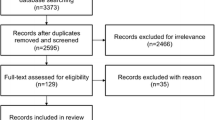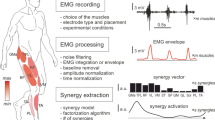Abstract
In order to determine the maximum joint stiffness that could be produced by cocontraction of wrist flexor and extensor muscles, experiments were conducted in which healthy human subjects stabilized a wrist manipulandum that was made mechanically unstable by using positive position feedback to create a load with the characteristics of a negative spring. To determine a subject's limit of stability, the negative stiffness of the manipulandum was increased by increments until the subject could no longer reliably stabilize the manipulandum in a 1° target window. Static wrist stiffness was measured by applying a 3° rampand-hold displacement of the manipulandum, which stretched the wrist flexor muscles. As the load stiffness was made more and more negative, subjects responded by increasing the level of cocontraction of flexor and extensor muscles to increase the stiffness of the wrist. The stiffness measured at a subject's limit of stability was taken as the maximum stiffness that the subject could achieve by cocontraction of wrist flexor and extensor muscles. In almost all cases, this value was as large or larger than that measured when the subject was asked to cocontract maximally to stiffen the wrist in the absence of any load. Static wrist stiffness was also measured when subjects reciprocally activated flexor or extensor muscles to hold the manipulandum in the target window against a load generated by a stretched spring. We found a strong linear correlation between wrist stiffness and flexor torque over the range of torques used in this study (20–80% maximal voluntary contraction). The maximum stiffness achieved by cocontraction of wrist flexor and extensor muscles was less than 50% of the maximum value predicted from the joint stiffness measured during matched reciprocal activation of flexor and extensor muscles. EMG recorded from either wrist flexor or extensor muscles during maximal cocontraction confirmed that this reduced stiffness was due to lower levels of activation during cocontraction of flexor and extensor muscles than during reciprocal contraction.
Similar content being viewed by others
References
Akazawa K, Milner TE, Stein RB (1983) Modulation of reflex EMG and stiffness in response to stretch of human finger muscle. J Neurophysiol 49: 6–27
Barrera EJ de la, Milner TE (1994) The effects of skinfold thickness on the selectivity of surface EMG. EEG Clin Neurophysiol 93: 91–99
Bennett DJ, Gorassini M, Prochazka A (1994) Catching a ball: contributions of intrinstic muscle stiffness, reflexes, and higher order responses. Can J Physiol Pharmacol 72: 525–534
Capaday C, Forget R, Milner TE (1994) A re-examination of the effects of instruction on the long-latency stretch reflex response of the flexor pollicis longus muscle. Exp Brain Res 100: 515–521
Carter RR, Crago PE, Gorman PH (1993) Nonlinear stretch reflex interaction during cocontraction. J Neurophysiol 69: 943–952
Chequer RS, Goodin DS, Aminoff MJ, Maeztu C (1994) Late electromyographic activity following stretch in human forearm muscles: physiological role. Brain Res 641: 273–278
De Luca CJ, Mambrito B (1987) Voluntary control of motor units in human antagonist muscles: coordination and reciprocal activation. J Neurophysiol 58: 525–542
De Serres SJ, Milner TE (1991) Wrist muscle activation patterns and stiffness associated with stable and unstable mechanical loads. Exp Brain Res 86: 451–458
Gielen CCAM. Houk JC (1984) Nonlinear viscosity of human wrist. J Neurophysiol 52: 553–569
Goodin DS, Aminoff MJ (1992) The basis and functional role of the late EMG activity in human forearm muscles following wrist displacement. Brain Res 589: 39–47
Hagbarth K-E, Wallin G, Löfstedt L (1975) Muscle spindle activity in man during voluntary fast alternating movements. J Neurol Neurosurg Psychiatr 38: 625–635
Hébert LJ, De Serres SJ, Arsenault AB (1991) Cocontraction of the elbow muscles during combined tasks of pronation-flexion and supination-flexion. Electromyogr Clin Neurophysiol 31: 483–488
Hogan N (1984) Adaptive control of mechanical impedance by coactivation of antagonist muscles. IEEE Trans Autom Control 29: 681–690
Houtz SJ (1964) Influence of gravitational forces on function of lower extremity muscles. J Appl Physiol 19: 999–1004
Humphrey DR, Reed DJ (1983) Separate cortical systems for control of joint movement and joint stiffness: reciprocal activation and coactivation of antagonist muscles. In: Desmedt JE (ed) Motor control mechanisms in health and disease. Raven, New York, pp 347–372
Hunter IW, Kearney RE (1982) Dynamics of human ankle stiffness: variation with mean ankle torque. J Biomech 15: 747–752
Iles JF, Pisini JV (1992) Cortical modulation of transmission in spinal reflex pathways of man. J Physiol (Lond) 455: 425–446
Jaeger RJ, Gottlieb GL, Agarwal GC (1982) Myoelectric responses at flexors and extensors of human wrist to step torque perturbations. J Neurophysiol 48: 388–402
Jankowska E, Padel Y, Tanaka R (1976) Disynaptic inhibition of spinal motoneurons from the motor cortex in the monkey. J Physiol (Lond) 258: 467–487
Jongen HAH, Denier van der Gon JJ, Gielen CCAM (1989) Inhomogeneous activation of motoneurone pools as revealed by co-contraction of antagonistic human arm muscles. Exp Brain Res 75: 555–562
Kearney RE, Hunter IW (1990) System identification of human joint dynamics. Crit Rev Biomed Eng 18: 55–86
Koh TJ, Grabiner MD (1993) Evaluation of methods to minimize cross talk in surface electromyography. J Biomech [Suppl 1] 26: 151–157
Lacquaniti F, Licata F, Soechting JF (1982) The mechanical behavior of the human forearm in response to transient perturbations. Biol Cybern 44: 35–46
Lacquaniti F, Borghese NA, Carrozzo M (1991) Transient reversal of the stretch reflex in human arm muscles. J Neurophysiol 66: 939–954
Lacquaniti F, Carrozzo M, Borghese NA (1993) Time-varying mechanical behavior of multijointed arm in man. J Neurophysiol 69: 1443–1464
Lee RG, Tatton WG (1982) Long latency reflexes to imposed displacements of the human wrist: dependence on duration of movement. Exp Brain Res 45: 207–216
Milner TE (1986) Judgment and control of velocity in rapid voluntary movements. Exp Brain Res 62: 99–110
Milner TE, Cloutier C (1993) Compensation for mechanically unstable loading in voluntary wrist movement. Exp Brain Res 94: 522–532
Nielsen J, Petersen N, Deuschl G, Ballegaard M (1993) Task-related changes in the effect of magnetic brain stimulation on spinal neurones in man. J Physiol (Lond) 471: 223–243
Riek S, Bawa P (1992) Recruitment of motor units in human forearm extensors. J Neurophysiol 68: 100–108
Rothwell J, Day B, Berardelli A, Marsden C (1984) Effects of motor cortex stimulation on spinal interneurones in intact man. Exp Brain Res 54: 382–384
Smith A (1981) The coactivation of antagonist muscles. Can J Physiol Pharmacol 59: 733–747
Tyler AE, Hutton RS (1986) Was Sherrington right about co-contractions? Brain Res 370: 171–175
Author information
Authors and Affiliations
Rights and permissions
About this article
Cite this article
Milner, T.E., Cloutier, C., Leger, A.B. et al. Inability to activate muscles maximally during cocontraction and the effect on joint stiffness. Exp Brain Res 107, 293–305 (1995). https://doi.org/10.1007/BF00230049
Received:
Accepted:
Issue Date:
DOI: https://doi.org/10.1007/BF00230049




